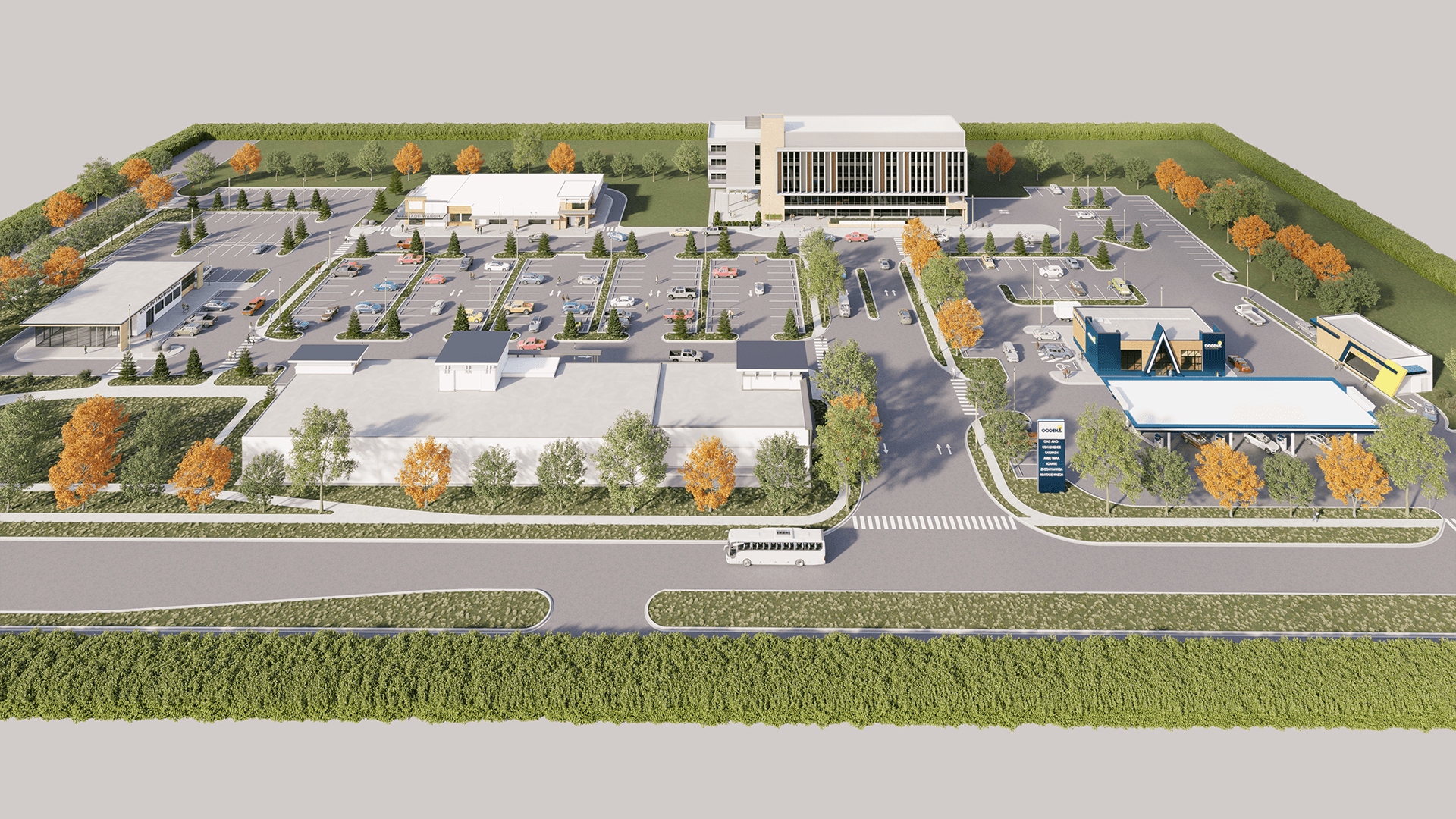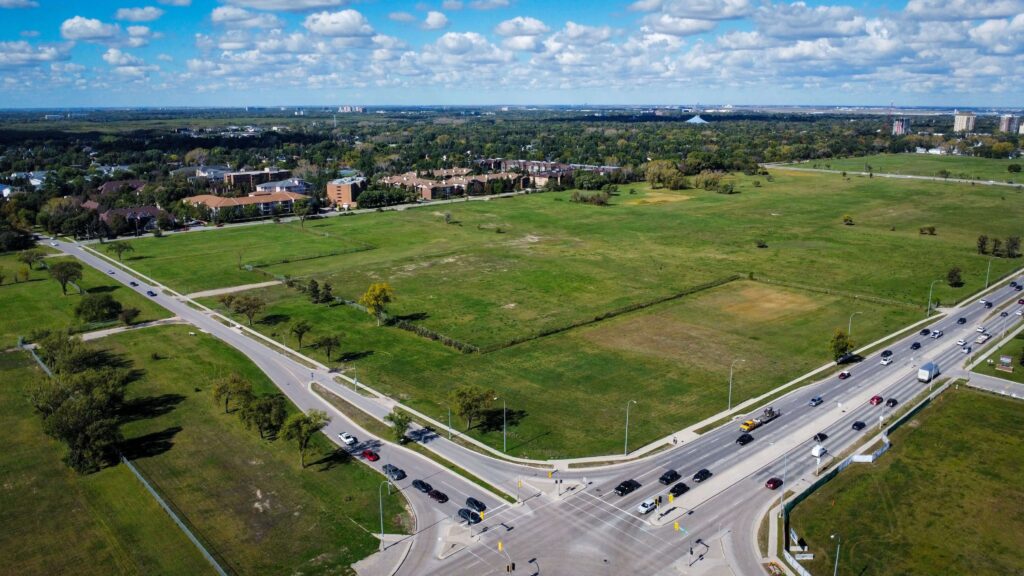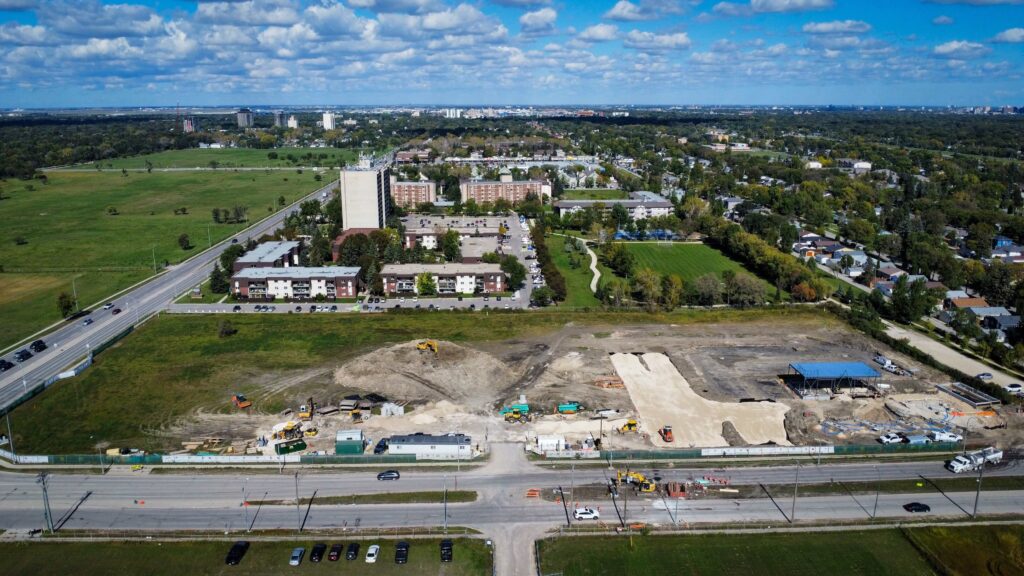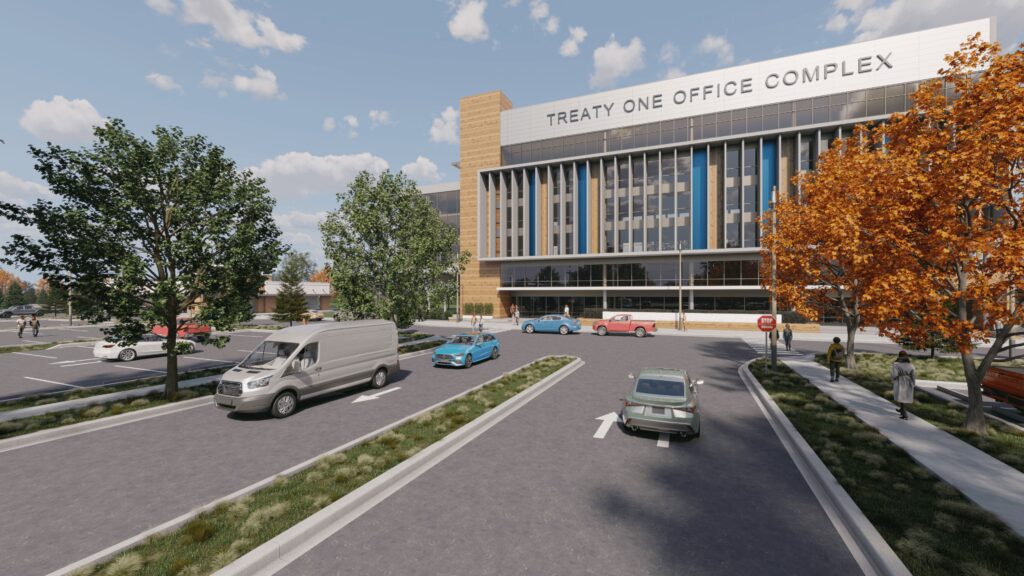
Naawi-Oodena is an urban reserve in Manitoba jointly controlled by Treaty One First Nations. The land was occupied by the Canadian military for many decades. The Treaty One Senior Management Team presented to the NIEDB in September 2023 and shared lessons from Treaty One’s 20-year journey to secure the land for the seven Treaty One First Nations.
Background
Treaty No.1 was signed in 1871 at Lower Fort Garry, promising each family of five 160 acres of land in exchange for lands in what is now southern Manitoba. Seven First Nations signed the first of the numbered treaties: Brokenhead Ojibway Nation, Long Plain First Nation, Peguis First Nation, Roseau River Anishinabe First Nation, Sagkeeng First Nation, Sandy Bay Ojibway First Nation, and Swan Lake First Nation.
The Canadian military used land on Treaty One Territory on the former Kapyong Barracks site from as early as 1919. In 2004, the military abandoned Kapyong Barracks, and in 2007 the Department of National Defense received approval to sell the property to the Canada Lands Company. Treaty One First Nations challenged the federal government’s attempt to sell the site, stating they had a right to the land under outstanding Treaty Land Entitlement claims.
In 2015, the Treaty No. 1 First Nations won a major victory when the court of appeals ruled that the federal government had failed to properly consult the First Nations before approving the sale of Kapyong Barracks in Winnipeg. The court ruled that this land was to be transferred to the seven Treaty No. 1 First Nations in the coming years. Prime Minister Stephen Harper then announced that the government would no longer continue to appeal the decision and the Addition to Reserve process began.

In preparation, the Treaty One Development Corporation (T1DC) was incorporated in July 2018 to pursue its goals of acquiring and developing the former Kapyong Barracks lands, and in 2019 a Comprehensive Settlement Agreement was signed by the Government of Canada and Chiefs of the Treaty No. 1 First Nations. This agreement allocated 68% of the site (108 acres / 43.8 ha) to Treaty One and identified 32% of the site (51 acres / 20.8 ha) to Canada Lands Company.
In 2015, the 160-acre site now known as Naawi-Oodena was officially repatriated to the Jointly Held Land Base of the Treaty One First Nations on December 16, 2022. Naawi-Oodena roughly translates to “centre of the heart and community” in the Anishinaabemowin language.
On April 1, 2023, the T1DC formally split into two entities, and formed Treaty One Nations Inc. (T1N). Whereas T1DC will continue with its goals to generate economic growth and prosperity for the seven Treaty No. 1 First Nations through development of the Jointly Held Treaty One Lands, T1N will pursue its commitments towards creation of a collective self-governance model for the Treaty One Jointly Held Lands
The Naawi-Oodena development project is a joint venture between the Treaty One Nations and Canada Lands Company, a federal Crown corporation that's a partner in the development.
This landmark development is the largest multi-use infill project in modern Winnipeg history and the single largest, strategically located First Nation-led Urban Economic Development Zone in Canada.
Challenges
Leadership of T1DC and T1N gave a presentation to the NIEDB in September 2023 about their 20-year long journey to redevelop the former Kapyong Barracks land. The Treaty One team spoke about the challenges they encountered securing political support for an urban reserve and overcoming skepticism about an Indigenous-controlled land development nestled in prime urban real estate. They faced institutional barriers, such as a rigid Additions to Reserve process which is not set up to accommodate First Nations owning a joint reserve, while operating under different land management systems. The team also encountered challenges securing funding from First Nations Bank, as initially there were no mechanisms for Treaty One Development Corporation to apply, as an amalgamation of several First Nations.
The Treaty One team also spoke to the NIEDB about having limited access to programs and procurement processes, with Indigenous businesses under-bidding their work to participate in the government procurement process.
Solutions
Before the redevelopment project could begin, the seven Treaty One First Nations first needed to develop a single, unified land regime to effectively govern and manage these lands. They also needed to establish a municipal services development agreement with the City of Winnipeg and manage environmental remediation requirements to cleanup and remove hazardous waste.
In July 2022, T1N and the City of Winnipeg signed a Municipal Development & Services Agreement for Naawi-Oodena, called the Gaawijijigemangit Agreement. The Agreement established the fundamental framework to begin developing the former Kapyong Barracks lands. The word Gaawijijigemangit means “Working Together in Partnership” in the Anishinaabemowin language.
The Gaawijijigemangit Agreement:
- established a government-to-government service agreement
- set a precedent for other Manitoba urban reserves and urban reserves across Canada
- enabled services and infrastructure for the largest urban reserve in Canada, and
- implemented a formal jurisdiction to create a competitive investment climate and help secure funding.

Although Naawi-Oodena is not the first joint reserve in Canada, or even the first ‘addition to reserve’ shared by a group of First Nations, Naawi-Oodena became the first joint reserve in Canada to be managed under a single unified Land Code, since joint reserves became eligible under the Framework Agreement for First Nations Land Management in 2018.
Results
Naawi-Oodena has become the largest First Nation-led land development initiative in Manitoba. It’s development will help shape Winnipeg’s future urban growth, and has the potential to generate significant economic investment.

Over the initial fifteen-year construction phase, the project will provide training, mentorship, and employment opportunities for the community, based on $84M in infrastructure investment and an estimated $705M to $1.05B in building construction. Upon completion, the development will include a mixed-use village, housing, a sports and recreation area, a cultural and educational campus, as well as community and commemorative spaces.
Naawi-Oodena serves as model for Nations across Canada to pursue collective governance for improved economic development opportunities.
“Our Leaders—including the ones who were instrumental in starting this process and unfortunately did not live to see this day—worked nearly two decades to see this historic step forward in realizing the fiscal and economic potential of Naawi-Oodena. It is a day to celebrate the reclamation of our Treaty lands and look forward to the new generation of reconciliation and progress.”
Treaty One Nations Chairperson Chief Gordon BlueSky, Brokenhead Ojibway Nation